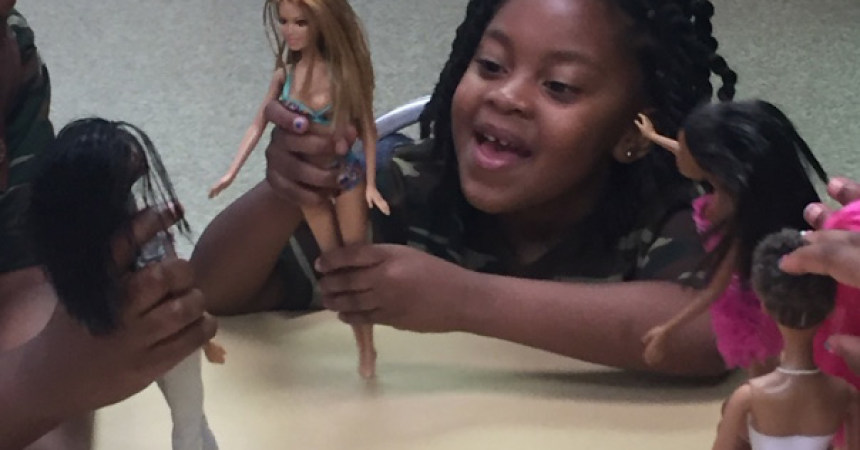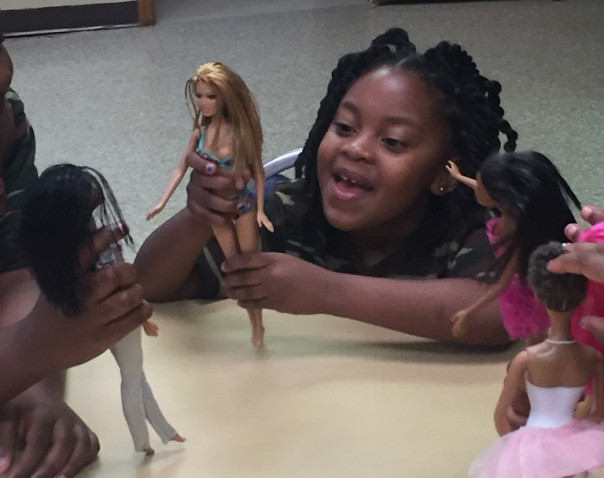
The self-esteem of a young woman: How much has changed since the 1940s “Doll Test”?

Arkenzi Williams explained how Barbie’s of different races make her feel.
Photo by Diamond Hunt-Coleman
By Diamond Hunt-Coleman
Senior Outlook Writer
Sitting in a room are five little girls laughing without a care in the world. From the outside they look like five regular girls participating in a group activity of Girl Scouting. On the inside many may perceive them to be the same “insecure” little girls that were part of the 1940s “Doll Study”. It`s not ‘till they begin to speak that it becomes apparent that they are light years ahead of the children of that time period.
Although many doll collectors may credit their high self-esteem and knowledge of self-worth to the ownership of dolls of their likeness, that is not the case for everyone. While living in the times of light skin v. dark skin, this epidemic seems to be teaching some young women how to love the skin they`re in, while teaching others to be ashamed of their skin. Furthermore, this epidemic is reinforcing the conclusions of the “Doll Tests” of the 1940s.
Using four identical dolls, except for color, psychologists Kenneth and Mamie Clark tested the racial perception of children. The children who participated were asked to identify the race of each doll and which they preferred. Due to the fact that most of the children associated positive characteristics with and preferred the White doll, the Clarks came to the conclusion that due to prejudice, discrimination and segregation, a feeling of inferiority was created among African American children and as a result their self-esteem was damaged. But are those same results true today?
Most people believe that Barbie is just a doll and fail to see that dolls are where girls get some of their first lessons about self-image and identity. Instead, think of her as a metaphor for a social fondness toward whiteness, and the privileges that go along with it. In a study conducted by York College, they were able to prove that girls of color can suffer from an identity distortion when they don’t see images of themselves represented in popular culture and the media. But that’s nothing new to many African -American circles.
As Brid`gette Israel watches her daughter interact with her fellow Girl Scouts, she realized that her daughter will not have to deal with some of the self-esteem issues she grew up with.
“Growing up we had Black dolls but there wasn’t an abundance of them,” said Israel. “I grew up knowing that I looked like the strong women in my family but at the same time, the media was busy telling me something different. I`m glad things have progressed some since I was her age.”
With dolls ranging in just about every skin tone known to man girls growing up in today`s society have representations of themselves in just about every major store across the nation.
While fumbling with an African American Barbie, 10 year-old JerMeny Israel seems to think that a difference has been made since the Clarks conducted their study.
“I know that I`m beautiful. My mommy tells me all the time. But it does help to see and own barbies that look like me,” said JerMeny. “I think when you have dolls that look like you, you can find confidence in yourself because you [look] like the doll.”
While there`s a fight for high self-esteem of the “brown girls” that doesn’t mean that girls of African American decent are being taught to hate other races. Mothers such as Claudia Williams are teaching their daughters love for all races using dolls.
“Of course I want her to have dolls that look like her. But that doesn’t mean that I don’t allow her to play with dolls of other races,” said Williams. “For example, the Disney Princesses are several different races and she plays with those. Now if I can find a Black Cinderella or a Black Snow White, then of course I`ll buy it but I`m not going to teach her not to love all races by prohibiting her from playing with dolls of different races.”
Although CNN`s Anderson Cooper aimed to recreate the Doll Study of the 1940s and it yielded the same results as the original, those same five young women from Girl Scout Troop 51 are living proof that children can look beyond color and see the beauty within. With the help of their parents and seeing dolls that resemble them, they are well on their way to having a strong and positive sense of self.







